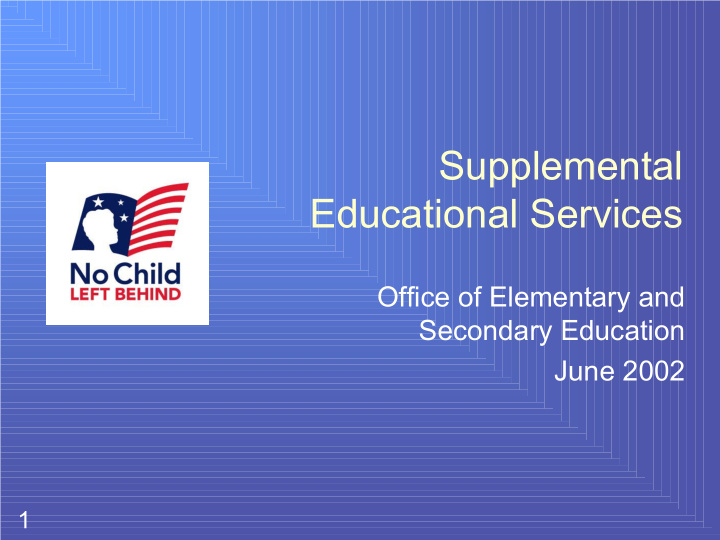



Supplemental Educational Services Office of Elementary and Secondary Education June 2002 1
Adequate Yearly Progress � Each state must establish a definition of adequate yearly progress (AYP) � Definition is used to measure the achievement of schools and districts over time 2 #
Accountability Measures � The goal is 100 percent proficiency for all students in 12 years. � Provides measurable objectives for all children and for specific groups � The goal is ambitious, but achievable. 3 #
When a Title I school fails to meet AYP for two consecutive years, the district must identify that school for improvement. A school’s plan for improvement must include ways to strengthen instruction and address the causes of failure. 4 #
New Options in No Child Left Behind � Parents of students in Title I schools in need of improvement will have the option to transfer to another public school in the district not in school improvement. � Parents of students in Title I schools identified for their 2nd year of school improvement will be eligible to receive supplemental services for their children. 5 #
Sample School Timeline Year 1 2001-02 Baseline Year 2 2002-03 Fail to make AYP Year 3 2003-04 Fail to make AYP 1 st year of school Year 4 2004-05 Technical assistance; improvement Public school choice 2 nd year of Year 5 2005-06 Technical assistance; school Public school choice; improvement supplemental educational services 6 #
Sample School Timeline Year 1 1998-99 Fail to make AYP Year 2 1999-2000 Fail to make AYP 1 st year of school Year 3 2000-01 improvement 2 nd year of school Year 4 2001-02 Technical assistance improvement 2 nd year of school Year 5 2002-03 Technical assistance; Public school choice; improvement supplemental (transition) educational services Timeline will vary by school 7 #
Charter Schools � If a charter school receives Title I, Part A funds, and � If it is identified for school improvement � Then it follows the same guidelines and must provide supplemental services to eligible students. 8 #
What are Supplemental Educational Services? � Extra academic assistance for low-income students who are attending Title I schools that have failed to make AYP for three or more years 9 #
Available services include Tutoring � Remediation � Academic intervention � Instruction must take place outside the � regular school day. 10 #
Why Supplemental Services? � To ensure that students increase their academic achievement, particularly in reading, language arts, and mathematics 11 #
Who is an eligible child? � Children from low-income families attending Title I schools in need of improvement � The child’s school must have failed to make AYP for three or more years 12 #
Role of the States � The States are ultimately responsible for identifying the eligible providers. � State educational agencies must develop objective criteria. � States will work with districts on providing geographically relevant lists. � They should consult with parents to promote participation and develop criteria for identifying providers. 13 #
Four Criteria for Providers � Demonstrated record of effectiveness in improving student achievement � Instructional strategies that are of high quality, based upon research, and designed to increase student achievement � Services must be consistent with instruction programs of the school district and with State academic content standards � Providers must be financially sound 14 #
Record of Effectiveness � State educational agencies are responsible for defining what would be acceptable evidence of effectiveness. 15 #
Provider Profile A provider may be a: � School entity (public or private) � Institution of higher education (public or private) � Nonprofit or for-profit organization � Faith based organization 16 #
Distance Learning Technology � Some areas may have a limited number of providers, so organizations that provide distance learning technology should be considered. � Providers that utilize distance learning technology do not have different criteria for eligibility. 17 #
Funding Supplemental Educational Services The lesser of (a) the amount the district � receives in Title I funding per poor child, or (b) the cost of the services themselves Supplemental educational services = � an amount equal to at least 5% of Title I allocation (if needed), and up to 20% depending upon the need for choice- related transportation. 18 #
Establishing priorities � In some circumstances when more students request services than the school district can fund, the school district must place a priority on serving students who are the lowest achieving. 19 #
Information for Parents � The States will be responsible for identifying the schools for which supplemental educational services is required and the eligible service providers. � School districts must give parents good, easy-to-understand information about supplemental services. � Communication between parents and districts must occur at least annually. 20 #
Parents choose a preferred supplemental educational service provider from the state-approved list. 21 #
As schools improve and make AYP for two consecutive years, they are no longer required to provide these services. 22 #
Recommend
More recommend